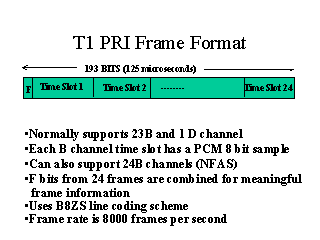
Unlike the BRI, the PRI does not terminate at the user's TE. It is usually used as a trunk connecting customer's switching equipment such as PBX or other NT2 to the LE. There are two types of PRI interface in use today and they are T1 PRI and E1 PRI.
PRI-T1 Interface:
This type of interface is in extensive use in North America, Japan and South Korea.. It is primarily based on the T1 carrier. It consists of 24 individual channels of 64kbps bandwidth. The PRI frame contains one framing bit plus a single 8-bit PCM sample from each of 24 channels , for a total of 193 bits per frame. At 8000 frames per second, this yields a total bit rate of 1.544Mbps, of which 1.536 Mbps is user data .

The single F bit in each frame cannot easily convey signalling information to the network. Therefore the F bits in 24 frames are grouped together to form a multiframe, which is described as the T1 extended superframing format . Each multiframe consists of 24 framing bits. The functions of these bits are as follows:
Frame alignment sequence(FAS): Six of the framing bits format repeated pattern for the purpose of synchronization.
Frame check sequence (FCS): Six of framing bits is meant for cyclic redundancy check (CRC) to determine if bit errors occured in the previous multiframe.
Maintenance Channel: The remaining 12 bits can be used for network
maintenance and operation messages. The specific operation of the
maintenance channel is not specified for the PRI.
__________________________________________________________________________________
Multi Frame
F- Bits
Number
------------------------------
FAS
M
FCS
__________________________________________________________________________________
1 - m -
2 - - e
3 - m -
4
0
-
-
24
1
-
-
_______________________________________________________________________
*FAS: Frame alignment sequence (001011....) M: Maintenance channel FCS: Frame Check Sequence Even though PRI-T1 interfaces use AMI signalling, Bipolar 8 Zero Substitution (B8ZS) is recommended to provide necessary number of ones so as to prevent long sequences of zeros. With B8ZS, an all-zero octet is replaced by the bit pattern 00011011 where bipolar violations occur in the fourth and seventh bit positions. Sice the injected bipolar violations appear in pairs, B8ZS is dc-balanced.
PRI-E1 Interface:
This interface (2.048Mbps) is based upon the E1 Carrier. It comprises 32 64kbps channels and is multiplexed into one frame. Time slot 0 is reserved for Physical Layer framing, synchronization and signalling. Time slots 1 through 15 and 17 through 31 are used for 30 B-channels, while time slot 16 is reserved for the D channel.

It uses High density bipolar of order 3 (HDB3)
digital signalling.HDB3 is dc balanced and uses bipolar violations
to ensure that there are no long runs of zeros in the transmission.
In this coding, a 4 zero bit pattern with the bit pattern x00V, where V
is a bipolar violation bit and x is set to 1 so that the no. of 1 bits
betwwen bipolar violations is odd.
A Quick Look on AMI, B8ZS and HDB3 coding
